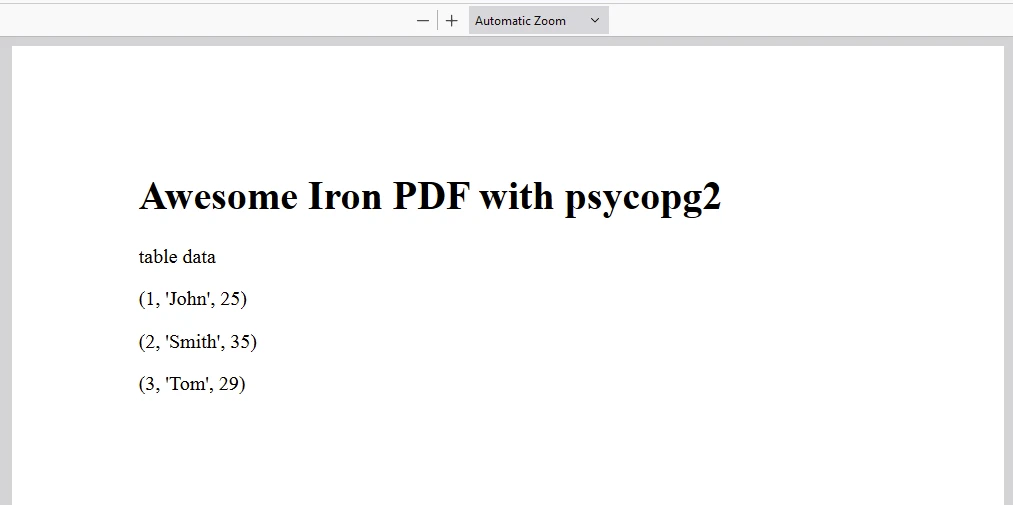Test in production without watermarks.
Works wherever you need it to.
Get 30 days of fully functional product.
Have it up and running in minutes.
Full access to our support engineering team during your product trial
The psycopg2 library is a popular PostgreSQL database adapter for Python programming language. It is known for its efficiency, thread safety, and complete implementation of the Python DB API 2.0 specification. Let's explore its features and see some code examples. Later in this article, we will learn about IronPDF, a PDF generation library from Iron Software.
Psycopg2 is designed to be efficient and secure, making it suitable for heavily multi-threaded applications. Some of its key features include:
You can install psycopg2 using pip:
pip install psycopg2Alternatively, you can use setup.py from the source package locally. You can obtain the source package from the source code repository here:
python setup.py build
sudo python setup.py installFor a stand-alone package that doesn't require a compiler or external libraries, you can use the psycopg2-binary package:
pip install psycopg2-binaryHere's a simple example to get you started with psycopg2.
First, you'll need to connect to your PostgreSQL database:
import psycopg2
# Connect to your PostgreSQL database
conn = psycopg2.connect(
dbname="your_dbname",
user="your_username",
password="your_password",
host="your_host",
port="your_port"
)
# Create a cursor object
cur = conn.cursor()You can execute SQL queries using the cursor object:
# Execute a query
cur.execute("SELECT * FROM your_table")
# Fetch all results
rows = cur.fetchall()
# Print the results
for row in rows:
print(row)Here's how to insert data into a table:
# Insert data into a table
cur.execute(
"INSERT INTO your_table (column1, column2) VALUES (%s, %s)",
("value1", "value2")
)
# Commit the transaction
conn.commit()Don't forget to close the cursor and connection when you're done:
# Close the cursor and connection
cur.close()
conn.close()The COPY command is helpful for bulk-loading data:
# Use COPY to load data from a file
with open('data.csv', 'r') as f:
cur.copy_from(f, 'your_table', sep=',')
conn.commit()You can listen for asynchronous notifications from the database:
# Listen for notifications
cur.execute("LISTEN your_channel")
# Wait for a notification
conn.poll()
while conn.notifies:
notify = conn.notifies.pop(0)
print("Got NOTIFY:", notify.payload)
IronPDF is a powerful Python library designed to create, edit, and sign PDFs using HTML, CSS, images, and JavaScript. It offers commercial-grade performance with a low memory footprint. Key features include:
HTML to PDF Conversion:
Convert HTML files, HTML strings, and URLs to PDFs. For example, render a webpage as a PDF using the Chrome PDF renderer.
Cross-Platform Support:
Compatible with various .NET platforms, including .NET Core, .NET Standard, and .NET Framework. It supports Windows, Linux, and macOS.
Editing and Signing:
Set properties, add security with passwords and permissions, and apply digital signatures to your PDFs.
Page Templates and Settings:
Customize PDFs with headers, footers, page numbers, and adjustable margins. Supports responsive layouts and custom paper sizes.
Standards Compliance:
Adheres to PDF standards such as PDF/A and PDF/UA. It supports UTF-8 character encoding and handles assets like images, CSS, and fonts.
import psycopg2
from ironpdf import *
# Apply your license key
License.LicenseKey = "Key"
# Connect to your local PostgreSQL database
conn = psycopg2.connect(
dbname="demo",
user="postgres",
password="postgres",
host="localhost",
port="5432"
)
# Create a cursor object
cur = conn.cursor()
cur.execute('''
CREATE TABLE IF NOT EXISTS users (
id INTEGER PRIMARY KEY,
name TEXT NOT NULL,
age INTEGER
)
''')
# Commit the transaction with connection object
conn.commit()
# Define the SQL statement for inserting data into the table
insert_query = '''
INSERT INTO users (id, name, age)
VALUES (%s, %s,%s)
'''
# Data to be inserted
userData1 = (1, 'John', 25)
# Execute the SQL command to insert data
cur.execute(insert_query, userData1)
# Data to be inserted
userData2 = (2, 'Smith', 35)
# Execute the SQL command to insert data
cur.execute(insert_query, userData2)
# Data to be inserted
userData3 = (3, 'Tom', 29)
# Execute the SQL command to insert data
cur.execute(insert_query, userData3)
# Commit the transaction
conn.commit()
# Execute a query
cur.execute("SELECT * FROM users")
# Fetch all results
rows = cur.fetchall()
renderer = ChromePdfRenderer()
# Create a PDF from a HTML string using Python
content = "<h1>Awesome Iron PDF with psycopg2</h1>"
content += "<p>table data</p>"
for row in rows:
print(row)
content += "<p>"+str(row)+"</p>"
# Close the cursor and connection
cur.close()
conn.close()
pdf = renderer.RenderHtmlAsPdf(content)
# Export to a file or Stream
pdf.SaveAs("Demopsycopg2.pdf")The script demonstrates interaction with a PostgreSQL database using `psycopg2`, data manipulation (creation, insertion, retrieval), and integration with `IronPDF` for document generation.
Data Retrieval: Executes a SELECT query to fetch all rows (`SELECT * FROM users`) from the `users` table and retrieves the results (`rows`).
For exception handling, you could wrap the script around a try-catch block to ensure all error operations are handled in the event one of the queries fails or the connection fails.


IronPDF runs on the Python license key. IronPDF for Python offers a free trial license key to allow users to test its extensive features before purchasing.
Place the License Key at the start of the script before using IronPDF package:
from ironpdf import *
# Apply your license key
License.LicenseKey = "key"Psycopg2 is a powerful and flexible library for interacting with PostgreSQL databases in Python. Its comprehensive feature set and efficient design make it an excellent choice for simple and complex database operations. IronPDF is a robust Python package and library that facilitates the creation, manipulation, and rendering of PDF documents directly from Python applications. It offers comprehensive features for generating PDFs from HTML content, integrating seamlessly with existing web technologies. With IronPDF, developers can efficiently automate generating reports, invoices, and other documentation, enhancing productivity and user experience. Its capabilities include interactive PDF forms, text extraction, merging and splitting PDFs, and the addition of security features like password protection. IronPDF's versatility and ease of use make it a valuable tool for developers looking to implement PDF generation and manipulation functionalities in their Python projects.